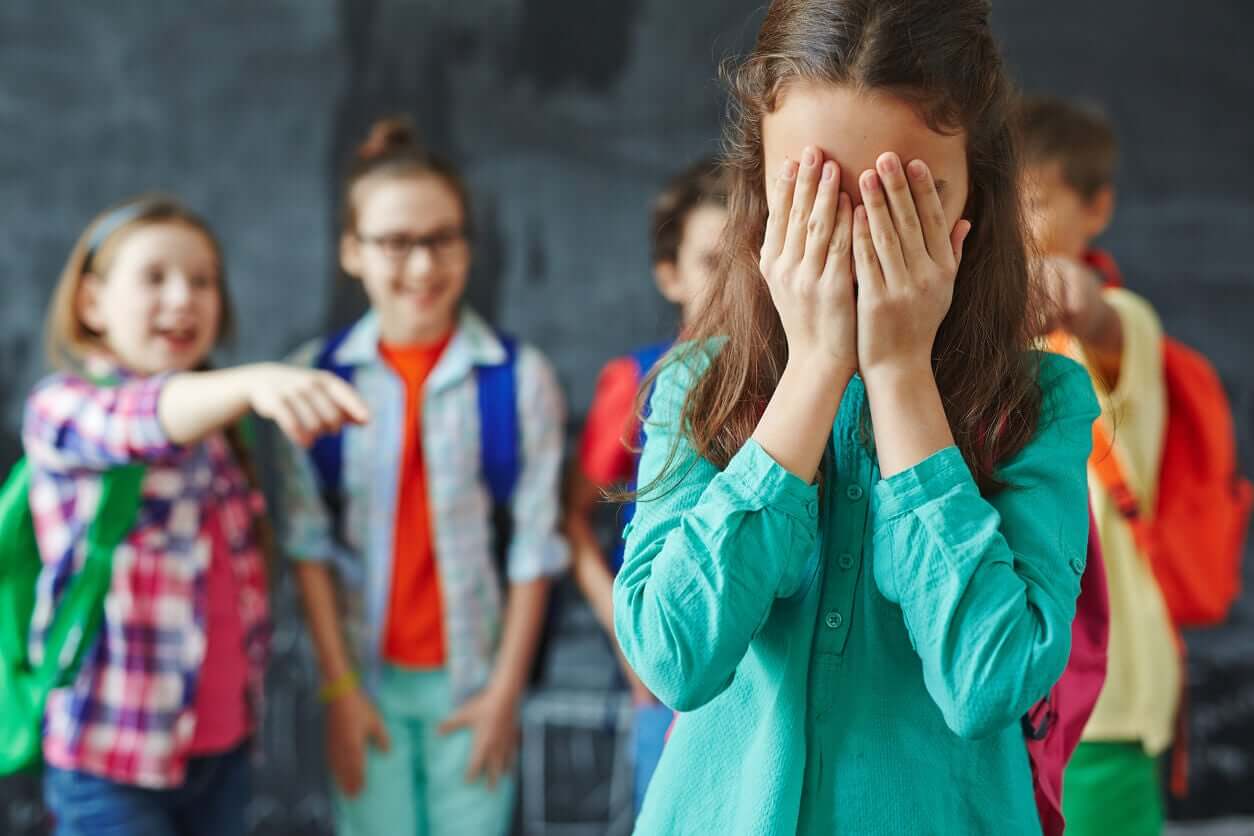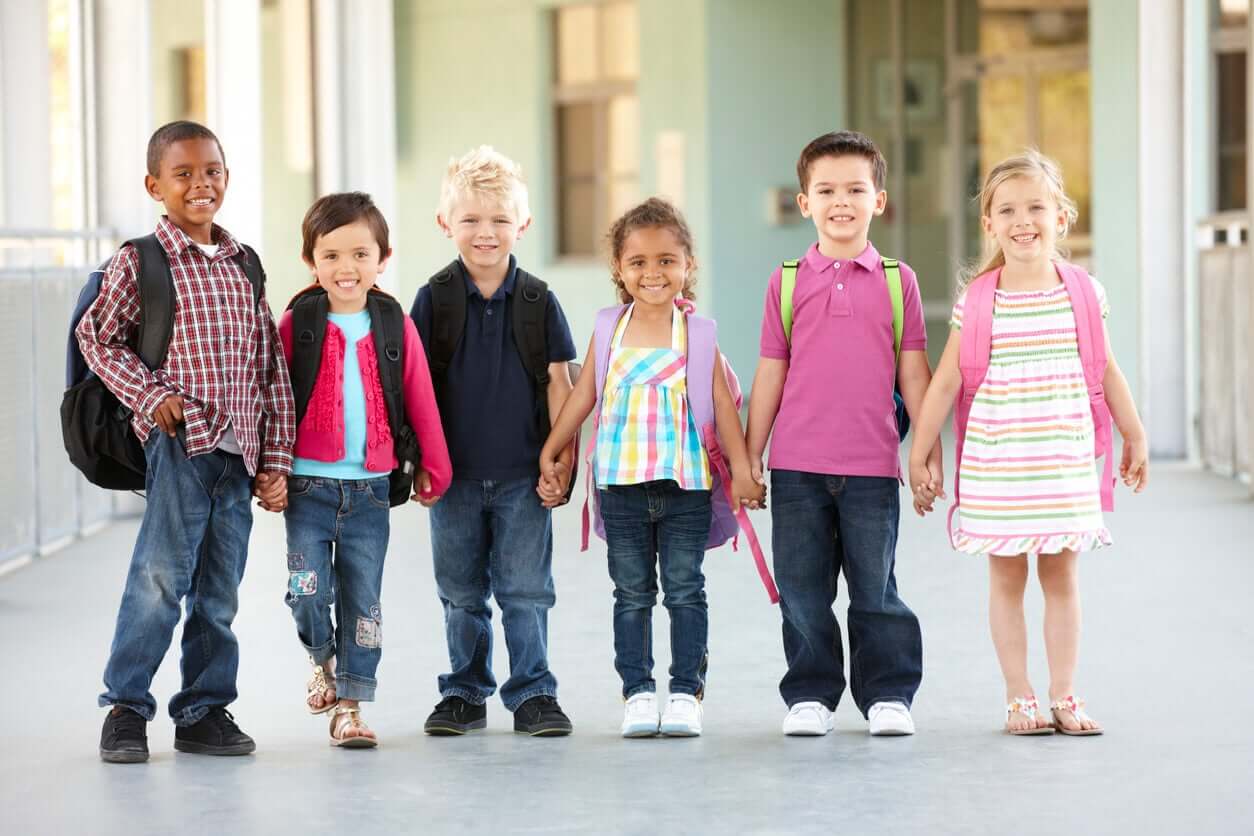9 Questions About Bullying and Their Answers


Written and verified by the psychologist Mara Amor López
Bullying isn’t something new, it already existed in ancient times. The difference is that now it has media coverage. This type of abuse that occurs continuously causes serious consequences for the victim, both physically and psychologically. On many occasions, bullying remains hidden, either because children feel ashamed or because adults don’t have the necessary tools to detect it. When reading the following lines, you may have doubts about how to know if your child is suffering from it. For this reason, we offer you the answers to the most frequent questions about bullying among parents.
Questions about bullying
To accompany children well, we need to better understand some issues related to this condition, such as causes, effects, and alternatives. Knowing well what you’re up against is always a positive thing. So, let’s dig in.
1. What is bullying?
When we talk about bullying, we’re referring to any type of harassment that’s exercised against a person, either directly or through electronic means.
Bullying is related to cases that occur within a school or any type of educational institution.
It can manifest itself through physical aggression, teasing, insults, discrimination, defamation, or any other type of psychological manipulation. All of them end up physically, emotionally, and mentally affecting the person who suffers it.
In order for this condition to exist, two main figures are needed: The one who harasses (the bullying child) and the one who suffers from it (the bullied child).
2. From what age can bullying start to occur?
Around 6 and 7 years old, children already begin to become aware of the damage they can cause to others and, in turn, they manage to recognize when someone tries to attack them.
3. What are the characteristics of the bullied child?
All children can be bullied, but bullies tend to look for more submissive children, who have few friends and are withdrawn. If they have to choose who to mess with, they do it with a child who will make them come out victorious.
4. What is the profile of the bullying child?
There’s no specific profile of a child bully, but what has been seen is that many of them have a history of having suffered some type of abuse at home or in their environment.
It may also happen that the bully suffers from a personality disorder, which prevents them from adapting properly to society. Therefore, when they hurt others, they achieve their well-being.

5. What signs in the child can make us suspect bullying?
The vast majority of children reveal this situation through changes in their behavior, such as sleeping problems, nightmares, depression, irritability, eating disorders, among others.
Normally, children don’t tell what happens to them in words.
In the case of adolescents, they tend to isolate themselves from their friends or their most intimate environment and seek to be alone. This type of behavior can alert us that something is happening and, if we observe it, it’s important to talk with them and with the school teachers. This way, we’ll be able to recognize the problem and help them alleviate the suffering.
6. How can we differentiate a fight at school from bullying?
Fights come up impulsively at one point. The adult in charge then separates them, reassures them, and, generally, it doesn’t happen again.
When we talk about harassment, the abuse of the child occurs in a constant and sustained way over time, both with physical and verbal aggression (isolation, humiliation, contempt, insults, among others).
7. Do boys and girls suffer from the same type of bullying?
In the case of boys, the bullying tends to consist of physical and verbal aggressions due to the impulsiveness of this gender. In contrast, girls tend to isolate the victim and exclude her from the peer group. When they’re older, they also tend toward aggressive behaviors.
8. What are the consequences of bullying?
The consequences usually have an impact on all spheres of the victim. Among them, we can mention the following:
- Anxiety
- Depression
- Suicidal thoughts
- Emotional disorders
- Low self-esteem
- Loss of self-confidence
- Psychosomatic problems
Bullying not only has consequences for bullied children but also for the family and those close to them, as they see the suffering of a loved one up close. For this reason, it’s important to offer support to the inner circle of the violated infant or adolescent.
9. Can we avoid bullying?
Yes, it’s possible to avoid bullying. But in order to stop the problem, the contribution of the whole of society is essential. Love and education play a fundamental role, as through them, we can instill values and responsibilities in order to live in harmony.
We have to establish in our children solid bases of respect towards themselves and towards others. We must instill empathy from an early age of life so that they learn to put themselves in the place of others before acting.
In order to stop bullying, what we have to do is raise up sensitive human beings who are capable of abiding by limits without fear, understanding the pain of others.

A harmonious coexistence favors respect and avoids any type of violent behavior.
About these questions about bullying, we can say…
These questions about bullying can help you understand a little more about this common problem during childhood and adolescence.
It’s important that, once you suspect it, you report it appropriately and seek psychological help urgently. You mustn’t forget that this will only stop if everyone does their part.
Let’s raise respectful, sensitive, empathetic children who are concerned for themselves and for others. Not selfish children who are incapable of putting themselves in anyone’s shoes. Together, we can say NO to bullying!
“My pain may be the reason for somebody’s laugh. But my laugh must never be the reason for somebody’s pain”
-Charles Chaplin-
Bullying isn’t something new, it already existed in ancient times. The difference is that now it has media coverage. This type of abuse that occurs continuously causes serious consequences for the victim, both physically and psychologically. On many occasions, bullying remains hidden, either because children feel ashamed or because adults don’t have the necessary tools to detect it. When reading the following lines, you may have doubts about how to know if your child is suffering from it. For this reason, we offer you the answers to the most frequent questions about bullying among parents.
Questions about bullying
To accompany children well, we need to better understand some issues related to this condition, such as causes, effects, and alternatives. Knowing well what you’re up against is always a positive thing. So, let’s dig in.
1. What is bullying?
When we talk about bullying, we’re referring to any type of harassment that’s exercised against a person, either directly or through electronic means.
Bullying is related to cases that occur within a school or any type of educational institution.
It can manifest itself through physical aggression, teasing, insults, discrimination, defamation, or any other type of psychological manipulation. All of them end up physically, emotionally, and mentally affecting the person who suffers it.
In order for this condition to exist, two main figures are needed: The one who harasses (the bullying child) and the one who suffers from it (the bullied child).
2. From what age can bullying start to occur?
Around 6 and 7 years old, children already begin to become aware of the damage they can cause to others and, in turn, they manage to recognize when someone tries to attack them.
3. What are the characteristics of the bullied child?
All children can be bullied, but bullies tend to look for more submissive children, who have few friends and are withdrawn. If they have to choose who to mess with, they do it with a child who will make them come out victorious.
4. What is the profile of the bullying child?
There’s no specific profile of a child bully, but what has been seen is that many of them have a history of having suffered some type of abuse at home or in their environment.
It may also happen that the bully suffers from a personality disorder, which prevents them from adapting properly to society. Therefore, when they hurt others, they achieve their well-being.

5. What signs in the child can make us suspect bullying?
The vast majority of children reveal this situation through changes in their behavior, such as sleeping problems, nightmares, depression, irritability, eating disorders, among others.
Normally, children don’t tell what happens to them in words.
In the case of adolescents, they tend to isolate themselves from their friends or their most intimate environment and seek to be alone. This type of behavior can alert us that something is happening and, if we observe it, it’s important to talk with them and with the school teachers. This way, we’ll be able to recognize the problem and help them alleviate the suffering.
6. How can we differentiate a fight at school from bullying?
Fights come up impulsively at one point. The adult in charge then separates them, reassures them, and, generally, it doesn’t happen again.
When we talk about harassment, the abuse of the child occurs in a constant and sustained way over time, both with physical and verbal aggression (isolation, humiliation, contempt, insults, among others).
7. Do boys and girls suffer from the same type of bullying?
In the case of boys, the bullying tends to consist of physical and verbal aggressions due to the impulsiveness of this gender. In contrast, girls tend to isolate the victim and exclude her from the peer group. When they’re older, they also tend toward aggressive behaviors.
8. What are the consequences of bullying?
The consequences usually have an impact on all spheres of the victim. Among them, we can mention the following:
- Anxiety
- Depression
- Suicidal thoughts
- Emotional disorders
- Low self-esteem
- Loss of self-confidence
- Psychosomatic problems
Bullying not only has consequences for bullied children but also for the family and those close to them, as they see the suffering of a loved one up close. For this reason, it’s important to offer support to the inner circle of the violated infant or adolescent.
9. Can we avoid bullying?
Yes, it’s possible to avoid bullying. But in order to stop the problem, the contribution of the whole of society is essential. Love and education play a fundamental role, as through them, we can instill values and responsibilities in order to live in harmony.
We have to establish in our children solid bases of respect towards themselves and towards others. We must instill empathy from an early age of life so that they learn to put themselves in the place of others before acting.
In order to stop bullying, what we have to do is raise up sensitive human beings who are capable of abiding by limits without fear, understanding the pain of others.

A harmonious coexistence favors respect and avoids any type of violent behavior.
About these questions about bullying, we can say…
These questions about bullying can help you understand a little more about this common problem during childhood and adolescence.
It’s important that, once you suspect it, you report it appropriately and seek psychological help urgently. You mustn’t forget that this will only stop if everyone does their part.
Let’s raise respectful, sensitive, empathetic children who are concerned for themselves and for others. Not selfish children who are incapable of putting themselves in anyone’s shoes. Together, we can say NO to bullying!
“My pain may be the reason for somebody’s laugh. But my laugh must never be the reason for somebody’s pain”
-Charles Chaplin-
All cited sources were thoroughly reviewed by our team to ensure their quality, reliability, currency, and validity. The bibliography of this article was considered reliable and of academic or scientific accuracy.
- Cabra Moreno, L. C., Cuervo Vargas, N., Gualdron Osorio, K. V., & Loaiza Cárdenas, M. M. (2019). Enfoque cognitivo conductual: principales factores que inciden en la conducta disfuncional de bullying desde un estudio de caso. [Trabajo de Grado, Institución Universitaria Politécnico Grancolombiano]. Disponible en: https://alejandria.poligran.edu.co/handle/10823/1528
- Fuentes Chacón, R. M., Simón Saiz, M., Garrido Abejar, M., Serrano Parra, M., Díaz Valentín, M., & Yubero Jiménez, S. (2019). ¿ Es posible detectar casos de acoso escolar a través de la presencia de problemas psicosomáticos? Pediatría Atención Primaria, 21(83), 231-238. Disponible en: https://scielo.isciii.es/scielo.php?pid=S1139-76322019000300002&script=sci_arttext&tlng=pt
- Padilla, M. P. L. (2008). La educación-en el hogar- “para la no violencia”. Edetania: estudios y propuestas socio-educativas, (35), 209-214. Disponible en: https://dialnet.unirioja.es/servlet/articulo?codigo=4958359
- Sánchez, P. N. R., & Mazón, J. C. Estilos parentales y acoso escolar en una muestra de niños de primaria. Alternativas en Psicología. Número 44. Febrero – Julio. Disponible en: https://www.alternativas.me/numeros/2-uncategorised/225-estilos-parentales-y-acoso-escolar-en-una-muestra-de-ninos-de-primaria
- Tangerini, V. R. (2021). Políticas de la imagen: La viralidad como estrategia. In XIV Jornadas de Sociología. Facultad de Ciencias Sociales, Universidad de Buenos Aires. Disponible en: https://cdsa.aacademica.org/000-074/696
- TRAUTMANN, A., (2008). Maltrato entre pares o “bullying”. Una visión actual. Rev Chil Pediatr 2008; 79 (1): 13-20. https://www.scielo.cl/scielo.php?pid=s0370-41062008000100002&script=sci_arttext
- Martínez, F., (2018). El bullying se gesta en la etapa de educación infantil. AMEI-WAECE. http://www.waece.org/items/actividades_valores/nueva/BOOKS%20GRATUITOS/Bullying/pdf.pdf
This text is provided for informational purposes only and does not replace consultation with a professional. If in doubt, consult your specialist.








